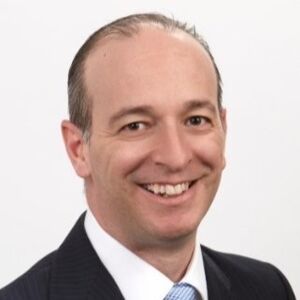"Quality, Valuation, and Time": Q&A with Aidan Farrell, Director of Global Small-Cap Equity at Eaton Vance

Aidan Farrell never had a Plan B. His natural fascination for understanding the global economy and how it works, meant he was always destined for a career in finance. Based in Eaton Vance's UK office, Aidan took up the role of director of small-cap equity in 2015. In an enlightening Q&A we find out what he sees are the advantages of global small-cap investing, about the daily part of his job that never ceases to excite him, and why an end of year confessional for his team of analysts is all part of the investment philosophy and culture at Eaton Vance.

Aidan Farrell never had a Plan B. His natural fascination for understanding the global economy and how it works, meant he was always destined for a career in finance. Based in Eaton Vance's UK office, Aidan took up the role of director of small-cap equity in 2015. In an enlightening Q&A we find out what he sees are the advantages of global small-cap investing, about the daily part of his job that never ceases to excite him, and why an end of year confessional for his team of analysts is all part of the investment philosophy and culture at Eaton Vance.
What percentage of a balanced portfolio do you feel Australian super funds should consider investing in global small caps?
Analysis carried out by Douglas Funds Consulting in conjunction with Heuristic Investing Systems suggests that an unhedged global small-cap allocation up to a total strategic asset allocation weighting of 5% is likely to improve the return/risk trade-off a typical Australian balanced portfolio that includes Alternatives (hedge funds and private equity).
What do you see are the main advantages of global small caps compared with 'All Caps' or large-cap indices?
I believe there are two main advantages. The first is the ability to focus solely on the most inefficient area of the stock market. For an equity strategy targeting alpha generation through bottom-up stock selection, this is the most fertile area to focus on. The second is that, with a sole focus on small-cap investing at the individual stock level, you really only need to be concerned about what you own as opposed to also having to focus on what you don't own. Take the example of the MSCI World Index, where Apple is currently the largest constituent at 2.29%. If a portfolio manager decides to be underweight and is proven wrong, that can be painful. If Apple continues to rise, the problem becomes more pressing.
Turning to the MSCI World Small Cap Index, the largest constituent has a weight of only 0.17%. If this stock is not held and happens to perform well, the cost to the fund is minimal, and the stock will eventually exit the small cap index, therefore ceasing to be a problem. The top 10 constituents of the MSCI World Index represent a combined weight of 10.8% versus 1.51% for the MSCI World Small Cap Index. Stock concentration risk is therefore more pressing for large-cap investors than small cap.
You hold 120 - 180 stocks in your portfolio. Can you tell us a little about the research process you use to screen the stocks?
To understand our process, you first need to understand our investment philosophy and culture.
Our philosophy focuses on three definable inputs - Quality, Valuation, and Time (QVT). Quality & Valuation are both factors that have demonstrated persistent outperformance over time. We also believe Quality, for which we have a clear definition, drives better capital preservation. On Time, we believe that a long-term mind-set that takes advantage of short-term price dislocations is the best way to buy quality companies at attractive valuations. We define time as patience in holding period, patience on entry points and we also define it as a valuable team resource. Discipline on quality allows us to maximise return-on-time by focusing team resources. Discipline on valuation combined with patience and a long-term mind-set ensures we do not overpay for quality.
Our culture is one of collaboration and team ownership, brought to life through a process of professional confrontation and debate, valuing and encouraging all investment input irrespective of levels of seniority.
The process is therefore designed to convert our chosen philosophy into a live portfolio in a team-based environment. We have a number of tools to help us achieve this goal including;
* Proprietary stock screens specifically designed to capture Quality, Valuation, and Time measures.
* A Weighted Price Potential (WPP) framework ensuring a rigorous assessment of the input to our risk-to-reward process.
* Portfolio exercises where the full team debates pre-assigned topics designed to challenge the team's thinking and the portfolio's positioning.
The key objective of these portfolio exercises is to avoid complacency. Examples of Portfolio Exercises include:
Robinson Crusoe: Analysts are asked to presume they will be marooned on a desert island for five years with no means of communication. They must select one stock they are happy to own in this scenario. The focus is on companies with structural advantages and an attractive multi-year outlook.
Half-baked sell ideas: Analysts must identify two stocks outside of their coverage area that they believe pose above-average risk, are near fair value, or should be sold for some other reason.
**End-of-year confessional:**The team recognises that mistakes are part of every investment process, but also believes it is important to admit to them and learn from them before moving on. Analysts are requested to identify two mistakes made in the past 12-months and describe what might have been done differently with the benefit of hindsight.
While proprietary research is the engine of the investment process, both formal and informal forms of communication are also vital. To that end, the team has daily, weekly and bi-weekly structured communication formats. The weekly research meeting serves as the cornerstone of the investment process. The meeting agendas are varied, but most frequently involve portfolio exercises, presentation of new investment ideas, reviewing performance, and reconfirming original investment rationales. The tone is one of professional confrontation - challenging assumptions, defending positions, debating the impact of various scenarios on investment ideas.
Can you tell us a little about your investment team and what you feel are their strengths in this area?
Experience, depth and proximity are the hallmarks of our investment team. Located in London, Boston and Tokyo, the 15-person investment team has 15 years of investment experience on average, with some members having been equity investors for over 20 years.
Aside from experience, a core strength is a passionate belief in and rigorous implementation of our QVT philosophy.
In what sectors do you see the greatest opportunities for growth in the global small cap universe over the next 5 years.
Our core skill-set is stock selection. We focus solely on generating alpha through the performance of the companies we invest in. Sector and geographic positions are kept close to benchmark. We therefore don't allocate time or capital to deciding what sectors have the best prospects.
And a little about you Aidan... what aspect of your job do you enjoy the most?
On a daily basis, I get to not just meet, but also question captains of industry in the form of CEOs and CFOs leading great franchises. That is a humbling privilege which never ceases to be exciting.
What was your motivation for a career in finance?
A natural fascination in understanding how the global economy works and why companies succeed or fail. Watching the movie 'Wall Street' also helped. There was something fascinating about Gordon Gekko (played by Michael Douglas) despite his principles!
If you weren't in finance, where would you be?
I have no idea! Never had a plan B.
What's the best piece of advice you have ever received?
If the ball's at your feet, kick it.



